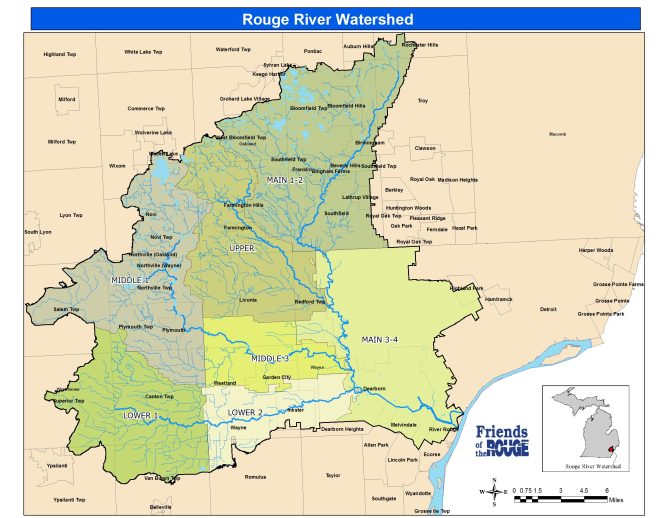
"Know Your Org" is an informational series designed to spotlight some of the wonderful organizations in our community. This month, we are highlighting the Friends of the Rouge.
Background
The Friends of the Rouge (FOTR) was founded in 1986 with the mission to raise awareness about the need to clean up the Rouge River in southeast Michigan.
Since then, they have worked towards environmental justice, learning along the way that social justice and equity of access for all residents of the area are important to their mission as well.
The FOTR approach, backed by decades of environmental research, is to encourage communities to work towards cleaning up and protecting the entire watershed. The watershed is a heavily urbanized area, including Oakland, Washtenaw, and Wayne counties. It includes 467 square miles that contain 127 miles of river, over 400 miles of creeks and tributaries, and more than 400 lakes and ponds. The Rouge drains into the Detroit River, which then flows into the Great Lakes.
The more the FOTR accomplish, the more every resident can see the benefits to their community and to themselves, which leads to more people becoming interested in helping to maintain the health of the watershed. Pretty impressive for a team of 15 people!

The library asked Sam Davis, a member of the Friend’s Education and Monitoring team, some questions about the FOTR, and she was kind enough to tell us more about the organization.
Q: What is the mission of the Friends of the Rouge? Can you give us your personal take on it and how it informs your work?
A: Our mission is to restore, protect, and enhance the Rouge River watershed through stewardship, education, and collaboration. FOTR started from a group of concerned citizens who saw how damaged the Rouge was from pollution due to years of industrial waste being discharged into the river both before and even after there were environmental protection laws in place to prevent these practices.
Q: When, why and how did the Friends of the Rouge start?
A: Friends of the Rouge started in 1986 as a group of watershed residents who came together out of concern for the massively degraded health of the river. After a century of industrialization in the region, the Rouge became a convenient transport for parts coming into manufacturing plants and also a disposal site for any unwanted waste.
As the health of the river declined and eventually was designated as an “Area of Concern,” a group of community members decided to come together and start cleaning up the river themselves. A volunteer event called Rescue the Rouge started and centered around physically pulling trash, car parts, shopping carts, plastic, etc. out of the river. From there, Friends of the Rouge was born and continues to grow and promote the health of the Rouge River.
Q: What is your job at the organization? What does your work entail?
A: I am the Education & Monitoring Assistant, which means that I help support and facilitate our programs surrounding our biological monitoring of the river (annual Bug Hunts, Stonefly Searches, fish surveys, and also recent work in aquatic invasive species detection, stream habitat assessments, etc.).
I work with our educational programs in the Rouge Education Project (a school program to get youth out to the river, learn about water quality, and take action to uplift their community and enact positive change) and with growing our outreach and engagement efforts so that community members are aware of the resources that are available to them.
Q: What are some current challenges the Rouge faces?
A: The river is slowly recovering from centuries of degradation and has some new challenges. So much of the watershed is paved over with roads and buildings that the river has difficulty absorbing and filtering polluted runoff.
The river rises very rapidly, causing banks to erode and send sediment into the water. Sediment and polluted runoff make it very difficult for fish and other aquatic life to survive.
Road salt application has vastly increased and poses a problem when it reaches streams. New threats include increased development and destruction of habitat and emerging contaminants like PFAS and pesticides.
Q: What keystone species populations do you monitor?
A: FOTR monitors fish, benthic macroinvertebrates (e.g. aquatic worms, insects, and animals like crayfish) and frogs and toads.
Q: How can people get involved with the Friends of the Rouge if they are interested?
A: We have regular volunteer opportunities to restore the watershed (native species plantings, rain garden maintenance and education, stormwater specialist training) and opportunities to recreate on the river (multiple paddling trips throughout the year).
We also have annual events to look for bugs/amphibians in the watershed and assess the health of the stream (bug hunts, stonefly searches, frog and toad survey), and educational opportunities for our youth in schools and for community members to learn about what they can do to uplift the Rouge and their community (Rouge Education Project, general outreach events/tabling).
It’s clear that the Friends of the Rouge have made a drastic and positive impact on the river, and on the communities that surround it. If you’ve ever enjoyed the natural wonders of the watershed and want to learn more or volunteer, check out their website to find more information on how to get involved.


Add a comment to: Know Your Org: Friends of the Rouge